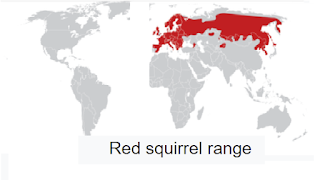 |
| The ring in question (image cropped) |
Miss Fowler said: [...] "It's human nature to wonder who owned it and their thoughts and feelings when they lost it, but it's far more interesting to think about the number of years of training the craftsman would have gone through to be able to create each hair on the squirrel's body and tail. "And to wonder how he might have felt working on such a precious item?"and gives the usual PAS "relevance to today" fluff, like a dealer's narrativisation in a sales spiel:
Miss Fowler said: "It's done with great skill. "You can tell it is definitely a red squirrel - with its tufted ears - which is also the only native species of squirrel."Nice to see some tree-hugging, all very laudable, but those comments tell the reader very little about the past users of that item and what they thought of the Sciuridae family and the context in which that object was deposited ("raises awareness of the importance of recording archaeological finds in their context"). It is archaeological outreach that the PAS is paid for (to be fair, even though this is a Treasure item,* the database writeup for this item is much fuller and more detailed than the majority of the FLOs do as 'preservation by documentation' these days).
In a parallel universe, however, the Alter County FLO is at this moment declaring "one day, due to the activities of artefact hunters and buyers, small metallic finds will be like the little red squirrel, absent from most of the places they were once common". That FLO earned the public money that was spent getting the archaeological and conservation message out. But that is in the parallel universe where Bonkers Britain was generally wiser.
Let us just note that no evidence is adduced that the ring was made in the British Isles, the red squirrel has a wider distribution across the northern hemisphere (figure from Wikipedia). Squirrel seal matrices are relatively common in the Midlands and several adjacent areas and the rings seem to be a subset of these.
*which the Treasure Act lays down should be reported elsewhere, the PAS was set up to be a record of non-Treasure items.








2 comments:
Oh good grief! Here we go with the PAS unawareness of heraldry again.
I rather doubt that the gold ring was just a pretty knick-knack for a Tudor/Stuart version of Chris Packham; the seal is obviously heraldic and a squirrel holding a nut/acorn was a fairly common device in England. Tracking the artefact down to its likely armigerous owner in the Cambridgeshire region might be a bit more instructive than expressing a wide-eyed amazement that a goldsmith could do what a goldsmith was trained to do. British craftsmen had moved on from merely knapping flint for some time by the period this ring was made.
As to "wonder[ing] how he might have felt working on such a precious item", I imagine the goldsmith felt pretty much the same as he felt working on anything else. It's what goldsmiths did. Engraving gold was part of their job - much like identifying artefacts and discussing them in an adult manner is supposedly part of an FLO's job.
As for the technology, glad you used the word engraved (which it is) and not the "etched" of the report of the Treasure Inquest.
Post a Comment